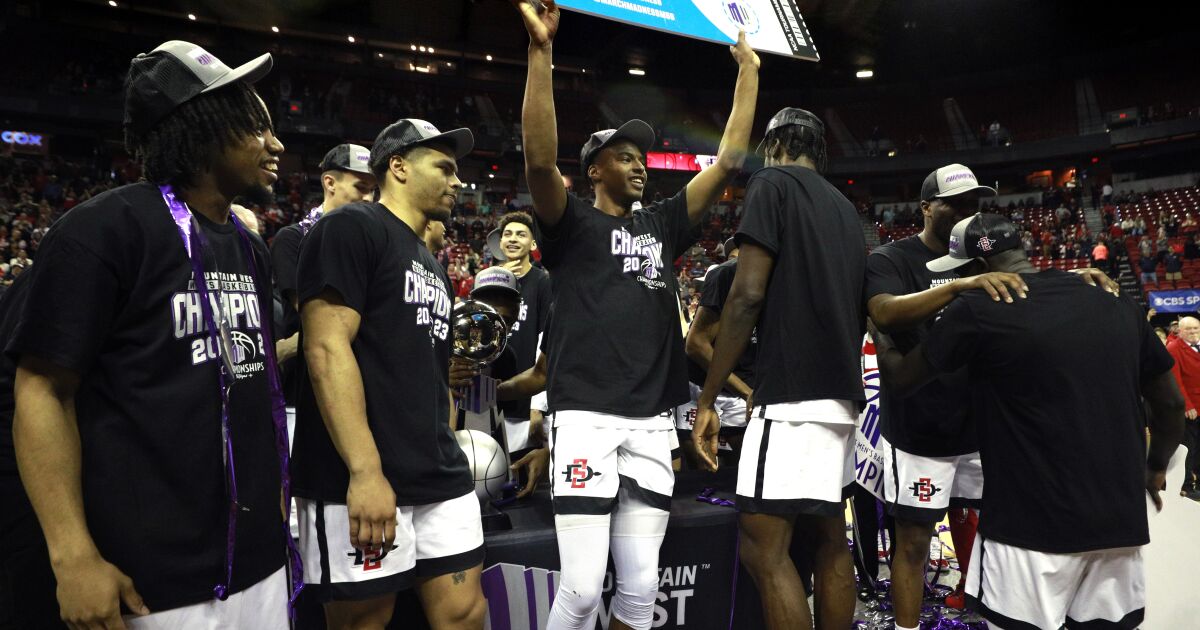In or out? SDSU to learn its Mountain West fate at Monday’s board meeting
5 min read
Twelve university presidents sit on the Mountain West Board of Directors. Eleven will join a video conference Monday afternoon to determine the status of the 12th.
Not invited is San Diego State President Adela de la Torre, who must wait until afterward, presumably in a phone call from Mountain West Commissioner Gloria Nevarez, to learn her university’s fate.
Is it out of the conference effective July 1, 2024? It is still in? Are there conditions, financial or otherwise?
De la Torre was removed from the board a month ago, as outlined in conference bylaws for a departing member. That was based on her conversations at a board meeting in Hawaii in early June, followed a week later by a letter to Nevarez and the other presidents “to formally notice that San Diego State University intends to resign from the Mountain West Conference effective June 30, 2024, or at an agreed upon later date.”
The Aztecs’ presumed destination: The Pac-12, once it secures a media rights deal and can consider expansion.
The June 13 letter, based on an open records search by On3.com from other conference campuses, apparently was not labeled as confidential. In a letter from Nevarez to the 11 other presidents the next day, she wrote: “Adela has just requested that Presidents not forward the letter to Athletic Directors to limit the chance of it becoming public. I’m guessing some may have already forwarded by now.”
The letter was soon leaked to ESPN.
“I was surprised the letter did not include a ‘confidential’ watermark,” Hawaii President David Lassner, who said he didn’t share it with his AD, wrote in an email to the other presidents, according to On3.com.
De la Torre sent two subsequent letters — one June 15, another June 30 — insisting SDSU had never left. The conference responded by saying it had and withheld a $6.6 million distribution due SDSU this month as the first installment of the $17 million exit fee.
“We will discuss the status of SDSU’s membership in the Conference at our July meeting of the Board of Directors,” said the most recent known correspondence from Nevarez to the university, dated July 1.
Monday’s meeting, then, will finally provide resolution to an increasingly contentious spat.
Or will it?
Neither side has commented for more than a month, and SDSU has not made public the entire breadth of correspondence with the Mountain West. The university readily released the first four letters through an open records request but denied the next three, citing exemptions.
Asked for clarification by the Union-Tribune, SDSU’s public records act coordinator responded in an email: “There is no appeal mechanism.”
Absent transparency about the situation, speculation has centered on three possible outcomes Monday at a meeting called specifically to discuss SDSU’s status.
The kumbaya scenario: This is the most likely result, according to multiple sources on both sides. The Mountain West agrees that SDSU did not provide formal notice of departure or, if it did, rescinded it before the June 30 deadline (after which the $17 million exit fee would double). SDSU gets its $6.6 million check for 2022-23, and the two sides link arms, sing each other’s praises and move on.
It effectively would bind SDSU to the Mountain West for two more years, since Athletic Director John David Wicker has repeatedly said the university cannot afford to pay the doubled exit fee for leaving with less than one year’s notice. Instead of joining the Pac-12 in the 2024-25 academic year, assuming they get an invitation, the Aztecs would give one-year notice of resignation by June 30, 2024, remain in the Mountain West for 2024-25 and leave in 2025-26.
The good-riddance scenario: The Mountain West plays hardball and kicks out the Aztecs, withholding its distribution shares this year and next year (as conference bylaws allow).
Nobody thinks this will actually happen, because it would involve jettisoning your marquee member who just played in basketball’s national championship game and earned $10 million in NCAA Tournament shares for the conference. Also, television partners CBS and Fox might have something to say about that.
The ‘welcome back, but’ … scenario: The Mountain West says SDSU can return but … with a financial penalty. That could be a flat fee — say, $1 million or $2 million — or reimbursement of the conference’s legal fees during the letter imbroglio.
One conference source described the board as a “cordial group” that generally is not vindictive. Also, none of the 11 presidents or Nevarez was around a decade ago, when SDSU gave notice of departure for the Big East in football (and Big West in most other sports) before slinking back when the Big East imploded.
SDSU, as counterintuitive as it sounds, might actually prefer this scenario because it could buy time by disputing it legally. And that’s why many think it won’t happen, because the Mountain West knows that.
The Mountain West already unwittingly granted SDSU an extra 17 days beyond the June 30 deadline for the lower exit fee, since several presidents were on vacation and unavailable to convene. Had the Pac-12 finalized a media rights deal, voted on expansion and invited the Aztecs before July 17, SDSU simply could have told the Mountain West: “You’re right, we gave our one-year notice, we’re leaving, here’s your $17 million, adios.”
A protracted legal battle over a conditional return to the conference could extend for weeks, even months. Pac-12 Commissioner George Kliavkoff presented a loose framework of a potential deal to his presidents last month but no hard numbers, and sources are now saying it might not be completed before Labor Day.
Who will still be around by then is a different matter.
Rumors persist that Colorado has grown impatient and is itching to jump to the Big 12. Arizona is known to have had conversations with the Big 12, and Arizona State and Utah are viewed as targets as well. Oregon, Washington and perhaps Stanford are said to have had back-channel conversations about following USC and UCLA to the Big Ten, the move that sent the conference realignment dominoes tumbling.
“Clearly, they’re in a different spot than the Pac-12 has been in in a long time,” Big 12 Deputy Commissioner Tim Weiser said Thursday at its football media day. “Trying to understand what their new TV media rights deal is seems to be one of the great secrets of college athletics right now. No one seems to know exactly what they do or don’t have.
“What I tell people is, I just know if we had something really good to talk about from a media rights standpoint, we’d be screaming it at the top of every mountain we could find. Sometimes that silence suggests the opposite.”
The SDSU-Mountain West silence, at least, figures to end Wednesday morning, when Nevarez is scheduled to speak during football media days at the Circa Resort in Las Vegas. Aztecs football coach Brady Hoke is slotted for Thursday, which would be the first time someone from SDSU has taken questions about the situation in more than a month.
A day later, it will be Kliavkoff’s turn during Pac-12 media day at Resorts World Las Vegas.






